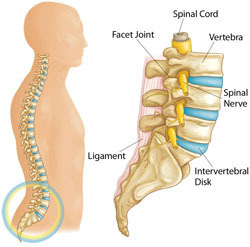The Vertebrae of the Human Spine: Structure, Function, and Clinical Relevance

Abstract
The vertebrae are the fundamental building blocks of the human spine, providing structural support, flexibility, and protection for the spinal cord. This article delves into the anatomy, development, and functions of vertebrae, as well as their clinical significance. Each vertebra’s unique characteristics are discussed, highlighting their roles in various regions of the spine.
Introduction
The vertebrae form a column of bones that extends from the skull to the pelvis. This vertebral column, or spine, is divided into five regions: cervical, thoracic, lumbar, sacral, and coccygeal. Each region has distinct vertebrae that contribute to the spine’s overall function. Understanding vertebral anatomy and pathology is crucial for diagnosing and treating spinal disorders.
Anatomical Structure
The vertebrae share a basic structure but exhibit regional variations to fulfill specific functions. A typical vertebra consists of the following components:
- Vertebral Body: The anterior, weight-bearing portion.
- Vertebral Arch: Encloses the spinal cord, formed by pedicles and laminae.
- Spinous Process: Projects posteriorly, providing muscle and ligament attachment.
- Transverse Processes: Extend laterally, serving as muscle and ligament attachment points.
- Articular Processes: Superior and inferior projections that form joints with adjacent vertebrae.
- Vertebral Foramen: The central hole through which the spinal cord passes.
- Intervertebral Foramina: Openings for the passage of spinal nerves.
Cervical Vertebrae
The cervical region consists of seven vertebrae (C1-C7), characterized by small bodies, bifid spinous processes, and transverse foramina. Unique features include:
- Atlas (C1): Supports the skull, allowing for the nodding motion.
- Axis (C2): Contains the odontoid process (dens) for rotational movement.
Thoracic Vertebrae
The twelve thoracic vertebrae (T1-T12) are distinguished by their larger bodies, long spinous processes, and facets for rib articulation. They provide stability and protect the thoracic organs.
Lumbar Vertebrae
The five lumbar vertebrae (L1-L5) have the largest bodies to support body weight. They allow for significant flexion, extension, and lateral movement due to their robust and sturdy structure.
Sacral and Coccygeal Vertebrae
The sacrum consists of five fused vertebrae (S1-S5) that form a triangular bone, articulating with the pelvis. The coccyx, or tailbone, is composed of four fused vertebrae (Co1-Co4), serving as an attachment point for ligaments and muscles.
Development
Vertebral development involves a complex process of embryogenesis:
- Notochord Formation: The notochord serves as a scaffold for the developing vertebral column.
- Somite Differentiation: Mesodermal somites differentiate into sclerotomes, which form the vertebrae.
- Chondrification and Ossification: Vertebrae initially form as cartilage, which gradually ossifies through endochondral ossification.
Function
The vertebrae have several essential functions:
- Structural Support: Maintain upright posture and bear the body’s weight.
- Protection: Encase and safeguard the spinal cord within the vertebral canal.
- Movement: Facilitate a range of motions, including flexion, extension, lateral bending, and rotation.
- Shock Absorption: Intervertebral discs between vertebrae act as cushions, absorbing shocks during movement.
Clinical Relevance
The vertebrae are susceptible to various conditions and injuries, each with significant clinical implications:
- Degenerative Disc Disease: Age-related deterioration of intervertebral discs, causing pain and reduced mobility.
- Herniated Disc: Displacement of disc material can compress spinal nerves, leading to pain and neurological symptoms.
- Spondylolisthesis: Slippage of one vertebra over another, often due to degenerative changes or congenital defects.
- Spinal Stenosis: Narrowing of the spinal canal, compressing the spinal cord and nerves, resulting in pain and functional impairment.
- Vertebral Fractures: Common in osteoporosis, can lead to severe pain and structural deformities.
- Scoliosis: Abnormal lateral curvature of the spine, affecting posture and potentially organ function.
Diagnostic and Therapeutic Approaches
Diagnosing vertebral disorders typically involves imaging techniques such as X-rays, MRI, and CT scans. Treatments vary depending on the condition and may include:
- Physical Therapy: Exercises to improve strength, flexibility, and overall function.
- Medications: Pain relievers, anti-inflammatory drugs, and muscle relaxants.
- Surgical Interventions: Procedures such as spinal fusion, laminectomy, and discectomy to stabilize the spine and relieve pressure.
- Minimally Invasive Techniques: Approaches like vertebroplasty and kyphoplasty to treat vertebral fractures.
Conclusion
The vertebrae are vital components of the human spine, providing structural integrity, protecting the spinal cord, and enabling a wide range of movements. Understanding their anatomy, development, and associated pathologies is crucial for effective diagnosis and treatment. Advances in medical science continue to enhance our ability to manage vertebral disorders, improving patient outcomes.
References
- Standring, S. (2020). Gray’s Anatomy: The Anatomical Basis of Clinical Practice (42nd ed.). Elsevier.
- Moore, K. L., Dalley, A. F., & Agur, A. M. R. (2013). Clinically Oriented Anatomy (7th ed.). Lippincott Williams & Wilkins.
- Sadler, T. W. (2018). Langman’s Medical Embryology (14th ed.). Wolters Kluwer.
- White, A. A., & Panjabi, M. M. (1990). Clinical Biomechanics of the Spine (2nd ed.). Lippincott Williams & Wilkins.
- Nordin, M., & Frankel, V. H. (2001). Basic Biomechanics of the Musculoskeletal System (3rd ed.). Lippincott Williams & Wilkins.
This comprehensive exploration of vertebral anatomy and pathology emphasizes the importance of continued research and education in maintaining spinal health and addressing spinal disorders.
🎓 Want to become a certified instructor?
This lesson is part of our FREE Anatomy course. Create a free account to track your progress and earn your certificate!